Space
Uranus ;Everything you need to know
Published
4 months agoon


Uranus ; Features, moons, wonders and everything you need to know
Uranus is the seventh planet from the sun and the third largest planet in the solar system. Although this planet shines brightly in the night sky to the naked eye, it is often mistaken for a star due to its slow orbit and low brightness. The planet is known for its significant orbital deviation, which causes it to rotate almost sideways and in line with its orbital plane.
Next to Neptune, Uranus is one of the two ice giants of the solar system, which has narrow rings and 27 moons. The planet was considered one of the priorities for solar system exploration in 2022, and NASA is expected to send a new probe to Uranus in the 2030s.
-
What does the planet Uranus symbolize?
-
How was Uranus formed?
-
Characteristics of the planet Uranus
-
Interesting facts about the planet Uranus
-
How far is Uranus from the Sun?
-
Why does Uranus almost turn sideways?
-
The seasons of Uranus
-
How many moons does Uranus have?
-
The rings of Uranus
-
Uranus and Neptune
-
Journey to Uranus
-
Conclusion
What does the planet Uranus symbolize?
Astronomer Frederick William Herschel observed Uranus with his telescope in 1781, and thus Uranus is the first planet observed with a telescope in the modern scientific era. At first, Herschel thought he was looking at a star or a comet, but the observations of other astronomers, especially “Johann Ellert” in the late 1700s, confirmed the existence of Uranus.
Herschel, who was of German-British origin, chose the name “Georgium Sidus” for the new planet, inspired by the name of King George III, but Bode suggested the name Uranus, meaning the Greek god of the sky. This was the first time that a planet was named after a Greek myth as the rest of the planets were named after Roman mythology.
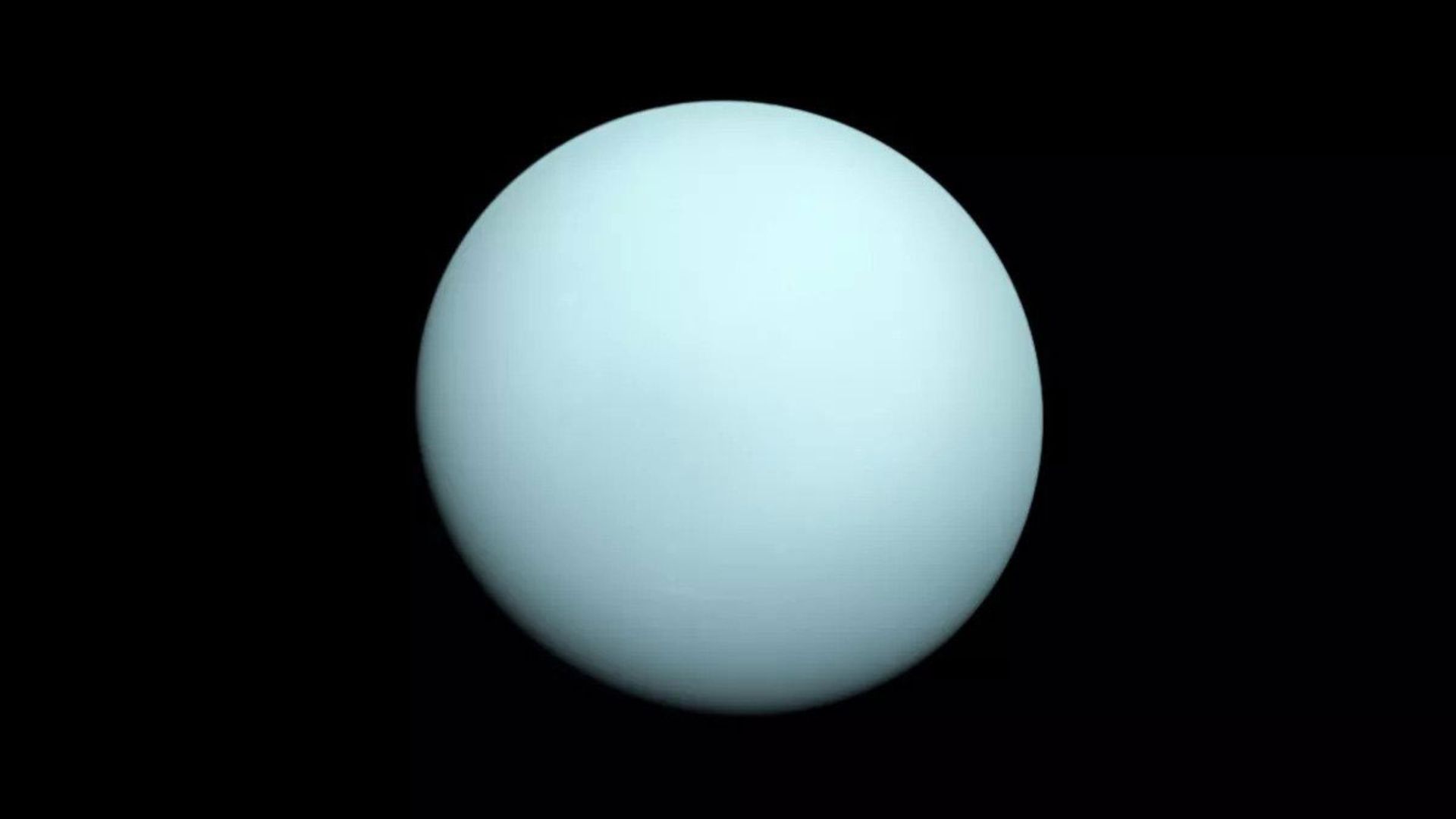 This image of Uranus was captured by the Voyager 2 probe in 1986.
This image of Uranus was captured by the Voyager 2 probe in 1986.
How was Uranus formed?
The planet Uranus was formed about 4.5 billion years ago. After the formation of the sun , gravity caused the gathering of gas and dust and the formation of this ice giant. Like its neighbor Neptune, Uranus probably formed at a closer distance to the Sun and then moved to the outer solar system about 4 billion years ago.
Characteristics of the planet Uranus
Like its neighbor Neptune, Uranus is known as an ice giant. In other words, more than 80% of the mass of this planet consists of icy substances such as water, methane and ammonia. In fact, ice does not have a colloquial meaning here, but rather a condensed mixture of watery substances. The term ice giant was proposed in the 1990s. At that time, researchers realized that Uranus and Neptune have a different composition compared to gas giants like Jupiter and Saturn , which are made entirely of hydrogen and helium. In the innermost part of Uranus, there is a small rocky core, whose temperature rises to 4982 degrees Celsius..
Most of Uranus’ atmosphere consists of hydrogen and helium, and small traces of methane can be found in it. In fact, the green and blue color of Uranus is the result of the presence of methane in the atmosphere of this planet. Although Uranus is not the most distant planet in the solar system, it has the coldest atmosphere among these planets. The reason for this issue is the small internal heat to compensate for the solar heat.
In 2021, researchers observed beautiful auroras in the upper atmosphere of Uranus. Under the upper atmosphere, high temperatures and pressures break apart methane molecules and release carbon, thus creating a crystalline form and a kind of diamond rain on Uranus .
Uranus is the coldest planet in the solar system
With a diameter of 50,724 km, Uranus is slightly larger than its neighbor Neptune, but less massive, making it the second least dense planet after Saturn. The minimum temperature on Uranus can reach minus 224 degrees Celsius, so that some areas of Uranus are colder than Neptune.
5% of Uranus’ atmosphere is hydrogen, 15.2% is helium and 2.3% is methane. The internal structure of this planet includes a mantle of water ice, ammonia and methane, as well as a core of iron and magnesium silicate.
Interesting facts about the planet Uranus
How far is Uranus from the Sun?
The planet Uranus is an average of 2.9 billion kilometers from the Sun, which is almost 20 times farther than the distance of the Earth from the Sun. A Uranian year is equal to 84 Earth years, while a Uranian day lasts only 17 Earth hours.
Why does Uranus almost turn sideways?
Uranus rotates at an angle of 98 degrees to its orbital axis. This feature makes Uranus a peculiar planet that rotates on its side. Planets such as Earth, Mars and Saturn have an orbital deviation of 25 degrees, and other planets such as Jupiter and Mercury have little or no deviation; But Uranus is the only planet in the solar system that rotates on its side. The most common explanation for this deviation of Uranus is that it probably collided with an Earth-sized protoplanet during its formation. If such a collision occurred, it definitely changed the orbit of Uranus.
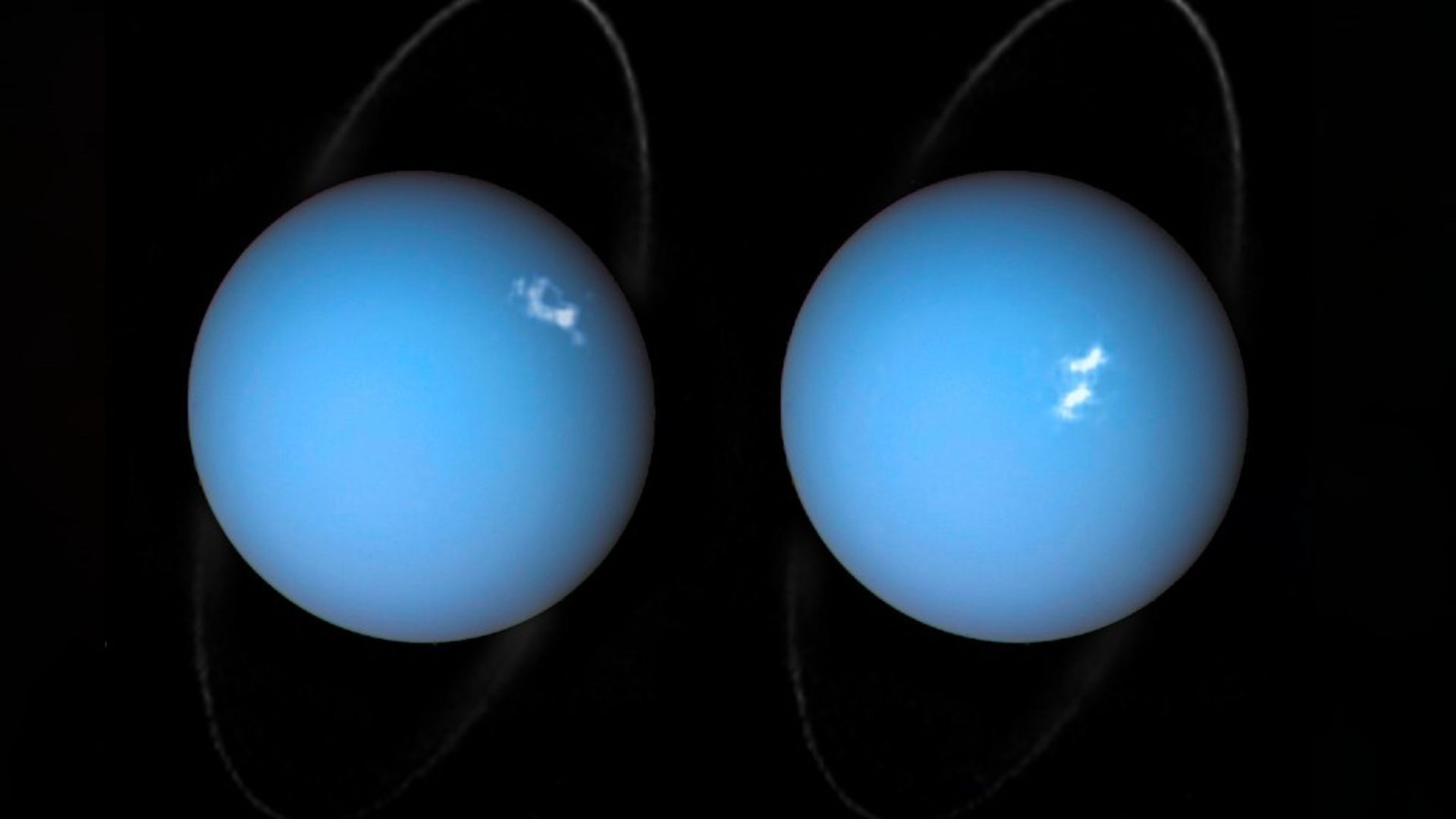 The Hubble Space Telescope observes Uranus every year
The Hubble Space Telescope observes Uranus every year
The seasons of Uranus
Uranus has an almost circular orbit around the Sun, so it is the same distance from the Sun throughout the year; But the axis of Uranus has a deviation of 98 degrees. This extreme deviation results in 21-year long seasons and strange weather. One Uranian year is equal to 84 Earth years. For almost a quarter of a year, the sun shines directly on one of the poles, and the other pole plunges into long winter darkness.
Each season on Uranus is equal to 21 Earth years
In most planets, the equator receives the most sunlight, which leads to an increase in heat and heat reaching the poles; But the equator of Uranus is hardly facing the sun; Therefore, warm air first originates from the pole facing the sun and then reaches the colder pole. On the other hand, the behavior of bands and clouds of Uranus is completely normal. The bands of this planet revolve around it exactly like the bands of Jupiter and Saturn, and instead of sunlight, the internal heat of this planet plays a decisive role in its weather.
How many moons does Uranus have?
According to NASA’s website, Uranus has 27 confirmed moons. The names of all the moons are taken from the works of William Shakespeare or the poet Alexander Pope. These moons are in alphabetical order: Ariel, Belinda, Bianca, Caliban, Cordilla, Crissida, Cupid, Desdemona, Ferdinand, Francisco, Juliet, Mab, Margaret, Miranda, Oberon, Ophelia, Perdita, Portia, Prospero, Puck, Rosaline, Estebus, Stefano, Sycorax, Titania, Trinculo, and Umbrell. The five largest moons of Uranus are: Miranda, Ariel, Umberil, Oberon and Titania. Below are some examples of the unique aspects of these moons:
- Miranda is the innermost and smallest of the five large moons of Uranus. The moon has canyons 12 times deeper than the Grand Canyon and multi-layered layers that look very old.
- Ariel is the brightest and probably the youngest moon of Uranus. The moon has several large impact craters and many small ones.
- Umberil is the darkest of the five moons. This moon has many old and large impact craters.
- Oberon, the outermost of the five moons, is also very old and full of impact craters and shows little sign of internal activity.
- Titania is the largest moon of Uranus and the eighth largest moon in the solar system. There is water ice and carbon dioxide in this moon. The origin of carbon dioxide is still unknown.
In addition to moons, the planet Uranus probably has a collection of Trojan asteroids. These objects have a common orbit with the planet and are located in a special region called the Lagrangian point. The first Trojan asteroid was discovered in 2013.
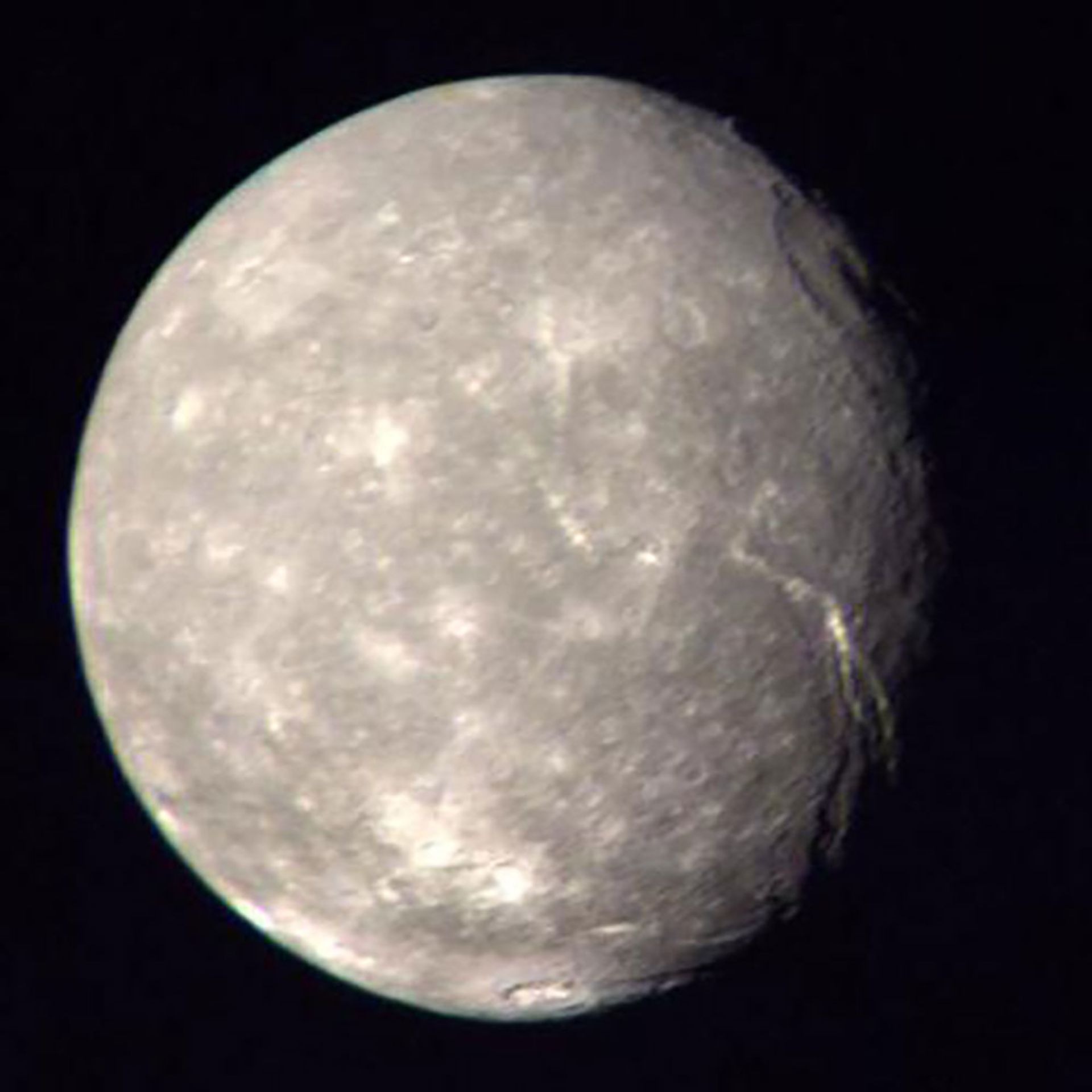 Image of Titania, the largest moon of Uranus.
Image of Titania, the largest moon of Uranus.
The rings of Uranus
Uranus has two sets of rings. The rings of the internal system are often narrow and dark gray in color. There are two outer rings, the innermost one is red like other dust rings and the outer one is blue like Saturn’s E ring. Scientists discovered a total of 13 rings for Uranus. According to the distance from the planet Uranus, the names of the rings are: Zeta, 6, 5, 4, Alpha, Beta, Eta, Gamma, Delta, Lambda, Epsilon, Nu and Mu. Some of the larger rings are surrounded by dust belts. In the new James Webb Space Telescope image of the planet Uranus , the glow of the rings is clearly visible.
According to a 2016 study, the rings of Uranus, Saturn and Neptune are probably the remnants of dwarf planets similar to Pluto , which were caught in the gravitational trap of these planets long ago. These dwarf planets were torn apart by the intense gravity of the giant planets and today they are arranged in a ring around them.
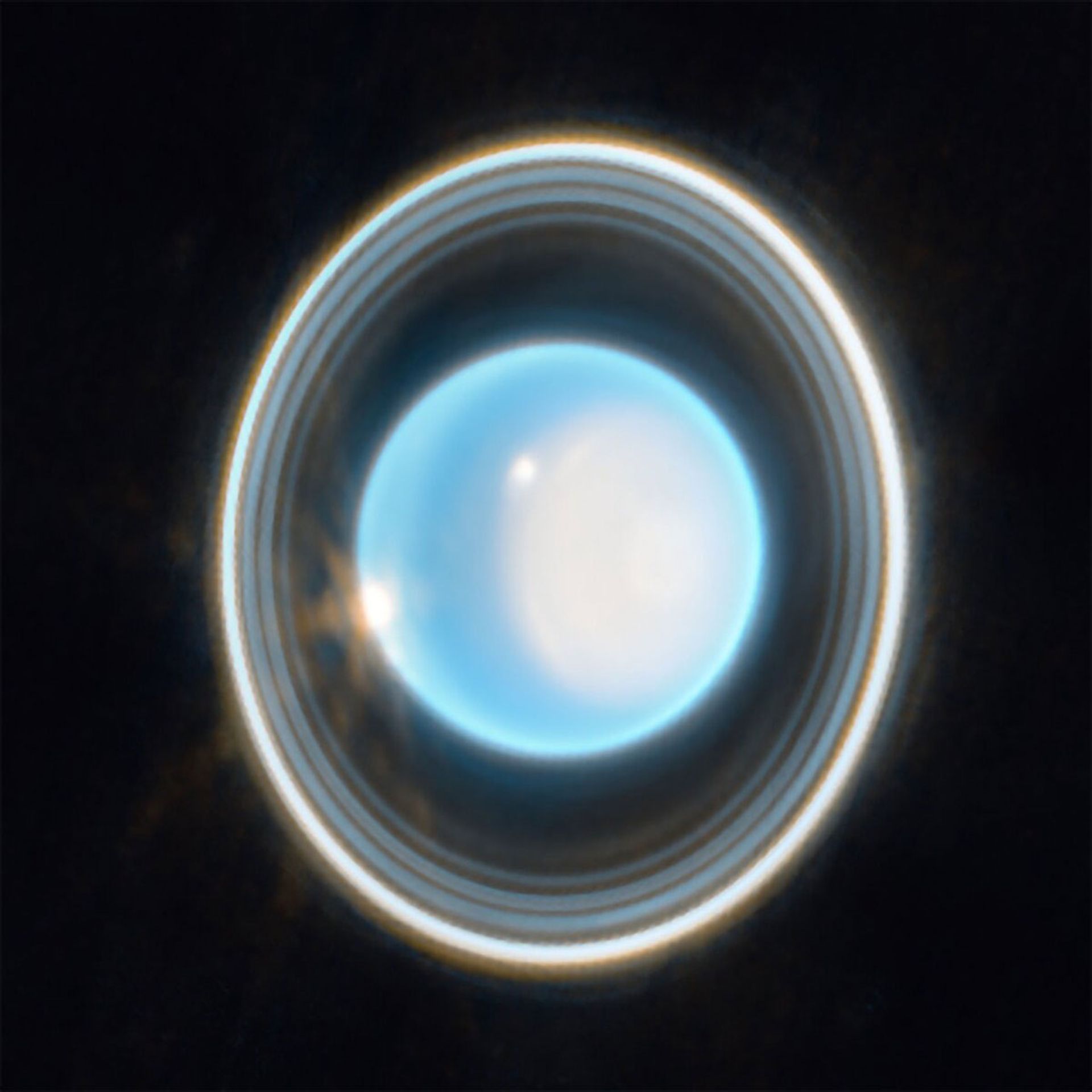 James Webb Space Telescope’s amazing new image of the planet Uranus. In this image, the rings are seen with a high shine.
James Webb Space Telescope’s amazing new image of the planet Uranus. In this image, the rings are seen with a high shine.
Uranus and Neptune
The two ice giants Uranus and Neptune are very similar in terms of mass and size, and both are the most distant planets in the solar system. Also, in terms of average density, they are similar to each other, but they cannot be considered identical twins.
Uranus and Neptune differ in terms of the amount of heat they emit, their axial tilt, and their lunar systems. Uranus has 27 smaller moons, while Triton, Neptune’s largest moon, is much larger.
Scientists think that the reason for these differences may be different formation processes, or maybe Uranus and Neptune were similar to each other at the beginning of their formation, and then an accident made this difference. Understanding the origin of the differences between Uranus and Neptune is essential to identifying the type of planets.
 Uranus is slightly larger than Neptune.
Uranus is slightly larger than Neptune.
Journey to Uranus
Only one spacecraft has ever visited Uranus: Voyager 2, which launched in 1977 and reached the icy giant in 1986. Voyager 2 discovered 10 moons and two sets of new rings for Uranus in this mission. According to data from Voyager 2, Uranus’ magnetic field is stronger than Saturn’s.
In 2022, researchers selected a new flagship mission for Uranus . The reason why Uranus is so important is because of its many mysteries, such as the mysterious X-rays. The planet Uranus can also give scientists many clues about the discovery of similar exoplanets because many of the worlds discovered outside the solar system have been planets the size of Uranus and Neptune.
The future Uranus probe, with a budget of approximately 2.4 billion dollars, will probably be launched in 2031 or 2032 and reach the planet in 2044 or 2045. This probe will be in the orbit of Uranus for several years and will investigate the interior of this planet, its atmosphere, magnetosphere, icy moons and its narrow rings.
Conclusion
The planet Uranus is the seventh planet in the solar system in terms of distance from the sun and one of the most mysterious planets. This planet rotates almost on its side due to extreme axial deviation and has turned blue-green due to the presence of methane in the atmosphere. Uranus has 27 moons and a series of dusty rings.
Voyager 2 is the only probe to have visited the planet Uranus in 1989. However, scientists are looking to launch a new probe towards this ice giant in the 2030s to reveal the secrets and mysteries of this mysterious planet.


You may like
-




Europa Clipper, NASA’s flagship probe was launched
-

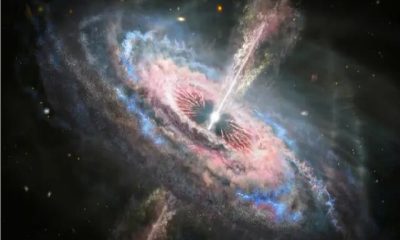


Dark matter and ordinary matter can interact without gravity!
-




James Webb Space Telescope deepens cosmology’s biggest controversy
-

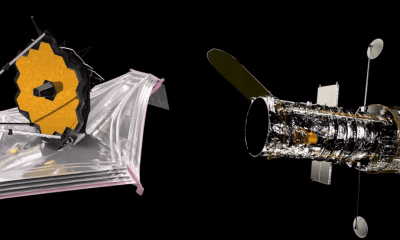


James Webb vs. Hubble
-

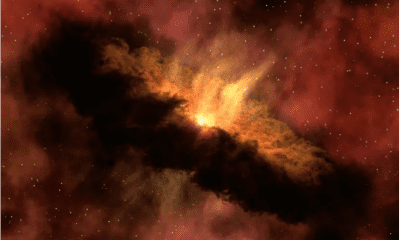


There is more than one way for planets to be born
-




Why is Jupiter one of the first targets of the James Webb Space Telescope?


Europa Clipper, NASA’s flagship probe was launched
After years of waiting, NASA’s Europa Clipper probe was finally launched on Monday at 7:36 p.m. Iran time from the Kennedy Space Center on top of SpaceX’s Falcon Heavy rocket and began a major astrobiology mission to Europa, the potentially habitable moon of Jupiter.
As SpaceX’s massive rocket powered by 27 powerful Merlin engines lifted off from pad 39A, NASA live broadcast reporter Dron Neal said, “The launch of Falcon Heavy with Europa Clipper will reveal the secrets of the vast ocean beneath the icy crust of Europa, Jupiter’s moon. It has been hidden, it will reveal.”
The engines of the two side boosters of the Falcon Heavy were shut down and separated from the central booster approximately three minutes after the flight. The central booster continued to fly for another minute, and then in the fourth minute of the launch, the separation of the upper stage from the first stage was confirmed. Finally, 58 minutes later, Europa Clipper was injected into interplanetary orbit as scheduled. A few minutes later, the mission team made contact with the probe, and people in the control room cheered and applauded.
Falcon Heavy’s unique launch
The launch of NASA’s new probe was delayed due to some mishaps. NASA and SpaceX initially planned to launch the Europa Clipper mission on Thursday, October 10; But with powerful Hurricane Milton hitting Florida’s Gulf Coast on Wednesday evening, a delay in the launch became inevitable. NASA shut down Kennedy Space Center to deal with the storm, and Europa Clipper was placed inside SpaceX’s hangar near Launch Pad 39A.
The recent launch was Falcon Heavy’s 11th flight overall and its second interplanetary mission. Also, this was the first flight of the Falcon Heavy, when all three boosters of the first stage of the rocket were deployed.
Typically, the Falcon Heavy and Falcon 9 first-stage boosters store enough fuel to perform landing maneuvers for recovery and reuse in the future; But Europa Clipper needed all the power that Falcon Heavy could provide in order to make it on its way to the Jupiter system.
A long way to the launch pad
In late 2015, the US Congress directed NASA to launch Europa Clipper using the Space Launch System (SLS), NASA’s massive rocket. SLS was still under construction at the time and was several years away from reaching the launch pad. The delay in completing the construction of this powerful rocket and NASA’s need to assign at least the first three versions of SLS to the Artemis lunar mission caused the Europa Clipper launch date to be in an aura of uncertainty.
In the 2021 House budget draft for NASA, the agency was directed to launch Europa Clipper by 2025 and, if possible, with SLS. However, due to the unavailability of the Space Launch System, NASA had to go to SpaceX’s Falcon Heavy. This decision was not without cost. As the most powerful rocket ever used in an operational mission, SLS can send Europa Clipper directly to the Jupiter system in less than three years.
Europa Clipper will use the gravitational assistance of Mars and Earth on its way to the Jupiter system
Now, even in Falcon Heavy’s fully disposable mode, the Clipper’s trip to Europe takes almost twice as long. The probe should make a flyby of Mars in February 2025 and a flyby of Earth in December 2026 to gain enough speed to reach its destination in April 2030.
Missile problems were not the only obstacles facing Europa Clipper on its way to the launch pad. For example, the rising costs of this five billion dollar probe forced NASA to cancel the construction of one of the probe’s science instruments. This instrument, named “Identification of Europa’s internal features using a magnetometer” (ICEMAG), was designed to measure Europa’s magnetic field.
Then in May 2024, NASA found that transistors similar to those used in Europa Clipper, which are responsible for regulating the probe’s electricity, were “failing at lower-than-expected radiation doses.” Following this discovery, NASA conducted more tests on the transistors and finally concluded in late August that these components could support the initial mission in the radiation-rich environment around Jupiter.
Ambitious mission to a fascinating moon

NASA/Jet Propulsion Laboratory-Caltech
Europa Clipper is one of NASA’s most exciting and ambitious flagship missions, and it has impressive features. For example, the mission probe is the largest spacecraft NASA has ever built for a planetary mission. Europa Clipper weighed almost 6,000 kg at the time of launch and will be more than 30 meters long (bigger than a basketball court) by opening its huge solar panels in space.
Clipper’s Europa destination is also a prominent location: Europa, one of Jupiter’s four Galilean moons. The moon is covered with an icy outer shell, which scientists believe hides a vast ocean of salty liquid water. For this reason, Europa is considered one of the best places in the solar system to support alien life.
In early 2012, studies began to look for potential plumes of water rising from Europa’s surface. Some researchers theorize that those water columns and vents from which the columns protrude may contain evidence of life living beneath the moon’s icy crust. However, NASA scientists have made it clear that Europa Clipper is not looking for extraterrestrial life in Europa; Rather, this probe will only investigate the potential of the submoon water environment to support life.
“If there’s life on Europa, it’s going to be under the ocean,” Bonnie Buratti, senior Europa Clipper scientist at NASA’s Jet Propulsion Laboratory, said in September. As a result, we cannot see it.” “We will be looking for organic chemicals that are prerequisites for life on the surface of the moon,” Borrati added. There are things we can observe; such as DNA or RNA; But we don’t expect to see them. As a result, [the probe] is only looking for habitable environments and evidence for the ingredients of life, rather than life itself.”
NASA scientists have made it clear that Europa Clipper is not looking for extraterrestrial life in Europa
Europa Clipper will collect data using a suite of nine scientific instruments, including visible and thermal cameras, several spectrometers, and special equipment to identify Europa’s magnetic environment. As stated on NASA’s Europa Clipper page, the probe will help scientists achieve three main goals:
- Determining the thickness of Europa’s ice sheet and understanding how Europa’s ocean interacts with the lunar surface.
- Investigating the composition of Europa’s ocean to determine whether it has the materials necessary to form and sustain life.
- Studying the formation of Europe’s surface features and discovering signs of recent geological activities; such as the sliding of crustal plates or the discharge of water columns in space.
Europa Clipper also transports Earth’s culture to the Solar System. A piece called “In Praise of Mystery: A Poem for Europe” by Edda Lemon, a famous American poet, is engraved in the artist’s own handwriting on a metal plate. In addition, the probe carries a coin-sized chip that contains the names of 2.6 million inhabitants of planet Earth.
6-year journey

Johns Hopkins University Applied Physics
If all goes according to plan, Europa Clipper will enter Jupiter’s orbit in April 2030. When the probe gets there, it will use up 50-60% of its 2,722 kg of fuel by performing an injection maneuver for 6-8 hours.
The injection maneuver puts Europa Clipper in an elliptical orbit around the gas giant. A series of long maneuvers will then be performed to align the trajectory so that the probe can fly by Europa more than 45 times and study it closely. In fact, Europa Clipper will remain around Jupiter throughout its mission; Because according to the launch environment of Europa, it will be very dangerous for the spacecraft to go around the moon.
If all goes according to plan, Europa Clipper will enter Jupiter’s orbit in April 2030
The first flight over Europe will not take place before the spring of 2031. NASA will use the first pass to make further corrections to Europa Clipper’s trajectory in preparation for the probe’s first science mission. With the start of scientific flybys in May 2031, Europa Clipper will aim its array of sensors towards the far hemisphere from Jupiter and will approach the surface of the moon up to 25 km. The second science campaign will begin two years later, in May 2033, in the Jupiter-facing hemisphere of Europa.
The end of the Europa Clipper mission is set for September 2034. At that time, NASA will crash the spacecraft into Ganymede, another Galilean moon of Jupiter. This disposal strategy was chosen because Ganymede is considered a relatively poor candidate to host life, and the mission team wanted to make sure they did not contaminate potentially life-hosting Europa with terrestrial microbes.
Space
Dark matter and ordinary matter can interact without gravity!
Published
2 weeks agoon
01/10/2024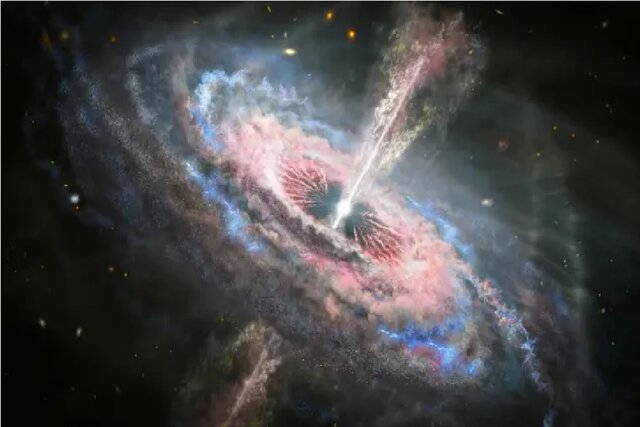

Preposition: For each; per.
Noun: A topology name.
Noun: which has mass but which does not readily interact with normal matter except through gravitational effects.
Adverb: Beyond all others.
Preposition: For each; per.
Noun: A topology name.
Dark matter and ordinary matter can interact without gravity!
Why is dark matter associated with the adjective “dark”? Is it because it harbors some evil forces of the universe or hidden secrets that scientists don’t want us to know? No, it is not. Such fanciful assumptions may sound appealing to a conspiracy theorist, but they are far from the truth.
Dark matter is called dark because it does not interact with light. So when dark matter and light collide, they pass each other. This is also why scientists have not been able to detect dark matter until now; it does not react to light.
Although it has mass and mass creates gravity, this means that dark matter can interact with normal matter and vice versa. Such interactions are rare, and gravity is the only known force that causes these two forms of matter to interact.
However, a new study suggests that dark matter and ordinary matter interact in ways other than gravity.
If this theory is correct, it shows that our existing models of dark matter are somewhat wrong. In addition, it can lead to the development of new and better tools for the detection of dark matter.
Read more: There is more than one way for planets to be born
A new missing link between dark and ordinary matter
Dark matter is believed to have about five times the mass of normal matter in our universe, which helps hold galaxies together and explains some of the motions of stars that don’t make sense based on the presence of visible matter alone.
For example, one of the strongest lines of evidence for the existence of dark matter is the observation of rotation curves in galaxies, which show that stars at the outer edges of spiral galaxies rotate at rates similar to those near the center. These observations indicate the presence of an invisible mass.
Also, for their study, the researchers studied six ultra-dim dwarf (UFD) galaxies located near the Milky Way. However, in terms of their mass, these galaxies have fewer stars than they should. This means they are mostly made up of dark matter.
According to the researchers, if dark matter and normal matter interact only through gravity, the stars in these UFDs should be denser in the centers and more spread out toward the edges of the galaxies. However, if they interact in other ways, the star distribution looks different.
The authors of the study ran computer simulations to investigate both possibilities. When they tested this for all six ultra-dim dwarf (UFD) galaxies, they found that the distribution of stars was uniform, meaning that the stars were spread evenly across the galaxies.
This was in contrast to what is generally observed for gravitational interactions between dark matter and normal matter.
What causes this interaction?
The results of the simulations showed that gravity is not the only force that can make dark matter and normal matter interact. Such an interaction has never been observed before, and it could change our understanding of dark matter and dark energy.
However, this study has a major limitation. What caused the interaction between the two forms of matter is still a mystery. While the current study provides tantalizing hints of a novel interaction, its exact nature and underlying causes remain unknown. Hopefully, further research will clarify the details of such interactions.
This study was published in The Astrophysical Journal Letters.
Space
James Webb Space Telescope deepens cosmology’s biggest controversy
Published
3 weeks agoon
26/09/2024

How the James Webb Space Telescope deepens cosmology’s biggest controversy
Summary of the article:
- Almost a century ago, Edwin Hubble discovered the expansion of the universe and calculated the expansion rate or the cosmic constant.
- Since Hubble, many groups have tried to measure the expansion rate of the universe. However, the values they obtained differed from the theoretical predictions. This difference is called Hubble tension.
- Scientists today use three methods to measure the expansion rate of the universe: Cephasian variable stars, TRGB red giant stars, and JAGB asymptotic giants.
- However, the Hubble tension still exists, indicating that the methods for calculating the Hubble constant suffer from a systematic flaw.
- Researchers hope to be able to use the James Webb telescope in the coming years to achieve more accurate measurements of the universe’s expansion rate and thus resolve the Hubble tension.
Almost a century ago, Edwin Hubble discovered that the universe was getting bigger. However, today’s measurements of how fast the universe is expanding are contradictory. These discrepancies show that our understanding of the laws of physics may be incomplete. On the other hand, everyone expected the sharp eyes of the James Webb telescope to bring us closer to the answer to the riddle; But a new analysis of the telescope’s long-awaited observations once again reflects inconsistent expansion rates from different types of data, while pointing to possible sources of error.
Two competing groups have led efforts to measure the rate of expansion of the universe, known as Hubble’s constant, or H0. A group led by Adam Reiss of Johns Hopkins University, relying on the known constituents of the universe and the governing equations, has consistently calculated the Hubble constant to be approximately 8 percent higher than the theory predicts the universe’s expansion rate. This discrepancy, known as the Hubble tension, indicates that the model of the cosmological theory may have missed some elements such as raw materials or effects that speed up the expansion of the universe. Such an element can be a clue to a more complete understanding of the world.
This spring, Reiss and his team published new measurements of the Hubble constant based on data from the James Webb Telescope and found a value consistent with their previous estimates. However, a rival group led by Wendy Friedman of the University of Chicago warns that more precise measurements are needed. The team’s measurements of the Hubble constant are closer to the theoretical estimate than Riess’ calculations, suggesting that the Hubble stress may not be real.
Since the commissioning of the James Webb Telescope in 2022, the astrophysical community has been waiting for Friedman’s multidimensional analysis based on telescope observations of three types of stars. The results are now as follows: the two-star types provide estimates of the Hubble constant that are in line with the theoretical prediction; While the results of the third star, which is the same type used by Reiss, are consistent with his team’s higher estimates of Hubble’s constant. According to Friedman, the fact that the results of the three methods are contradictory does not mean that there are unknown physical foundations, but that there are some systematic errors in the calculation methods.
Contradictory world
The difficult part of measuring cosmic expansion is measuring the distance of space objects. In 1912, American astronomer Henrietta Levitt first used pulsating stars known as Cephasian variables to calculate distances. These stars flicker at a rate proportional to their intrinsic luminosity. By understanding the luminosity or radiant power of a Cephasian variable, we can compare it with its apparent brightness or dimming to estimate its galaxy’s distance from us.
Edwin Hubble used Levitt’s method to measure the distances to a set of galaxies hosting the Cephasian variable, and in 1929 he noticed that the galaxies that are farther away from us are moving away faster. This finding meant the expansion of the universe. Hubble calculated the expansion rate to be a constant value of 500 km/s per megaparsec. In other words, two galaxies that are 1 megaparsec or approximately 3.2 million light years apart are moving away from each other at a speed of 500 km/s.
As progress was made in calibrating the relationship between the pulsation frequency of Cepheids and their luminosity, measurements of the Hubble constant improved. However, since the Cephasian variables are very bright, the whole approach used has limitations. Scientists need a new way to measure the distance of galaxies from each other in the infinite space.
In the 1970s, researchers used Cephasian variables to measure the distance to bright supernovae, and in this way they achieved more accurate measurements of the Hubble constant. At that time, as now, two research groups undertook the measurements, and using supernovae and Cephasian variable stars, they achieved contradictory values of 50 km/s per megaparsec and 100 km/s per megaparsec. However, no agreement was reached and everything became completely bipolar.
 Edwin Hubble, the American astronomer who discovered the expansion of the universe, stands next to the Schmidt telescope at the Palomar Observatory in this photo from 1949.
Edwin Hubble, the American astronomer who discovered the expansion of the universe, stands next to the Schmidt telescope at the Palomar Observatory in this photo from 1949.
The launch of the Hubble Space Telescope in 1990 gave astronomers a new and multi-layered view of the universe. Friedman led a multi-year observing campaign with Hubble, and in 2001 he and his colleagues estimated the expansion rate to be 72 km/s/Mpa with an uncertainty of at most 10%.
A Nobel laureate for the discovery of dark energy, Reiss got into the expansion game a few years later. In 2011, his group found the Hubble constant to be 73 with a three percent uncertainty. Soon after this, cosmologists excelled in another way. In 2013, they used Planck’s observations of light left over from the early universe to determine the exact shape and composition of the early universe.
In the next step, the researchers connected their findings to Einstein’s theory of general relativity and developed a theoretical model to predict the current state of the universe, up to approximately 14 billion years into the future. Based on these calculations, the universe should be expanding at an approximate rate of 67.4 km/s per megaparsec with an uncertainty of less than one percent.
Reese’s team measurement remained at 73, even with the improved accuracy. This higher value indicates that the galaxies today are moving away from each other at a faster rate than theoretically expected. This is how the Hubble tension was born. According to Reiss, today’s Hubble tension shows us that something is missing in the cosmological model.
The missing factor could be the first new element in the universe to be discovered since dark energy. Theorists still have doubts about the identity of this agent. Perhaps this force is some kind of repulsive energy that lasted for a short time in the early universe, or perhaps it is the primordial magnetic fields created during the Big Bang, or perhaps what is being missed is more about ourselves than the universe.
Ways of seeing
Some cosmologists, including Friedman, suspected that unknown errors were to blame for Hubble’s tension. For example, Cephasian variable stars are located in the disks of younger galaxies in regions full of stars, dust, and gas. Even with Hubble’s fine resolution, you don’t see a single Cephasian variable, according to George Afstatio, an astrophysicist at the University of Cambridge. Rather, you see it overlapping with other stars. This density of stars makes measurements of brightness difficult.
When the James Webb Telescope launches in 2021, Reiss and his colleagues will use its powerful infrared camera to peer into the crowded regions that host the Cephasian variables. They wanted to know whether the claims of Friedman and other researchers about the effect of the area’s crowding on the observations were correct.
 The 6.5-meter multi-section mirror of the James Webb Space Telescope at NASA’s Goddard Space Flight Center in Maryland. This mirror passed various test stages in 2017.
The 6.5-meter multi-section mirror of the James Webb Space Telescope at NASA’s Goddard Space Flight Center in Maryland. This mirror passed various test stages in 2017.
When the researchers compared the new numbers to distances calculated from Hubble data, they saw a surprising match. The latest results from the James Webb telescope confirmed the Hubble constant measured by the Hubble telescope a few years ago: 73 km/s/Mpa with a difference of one kilometer or so.
Concerned about crowding, Friedman turned to alternative stars that could serve as distance indicators. These stars are found in the outer reaches of galaxies and away from the crowd. One of those stars belongs to the group ” Red Giant Branch ” or TRGB for short. A red giant is an old star with a puffy atmosphere that shines brightly in the red light spectrum. As a red giant ages, it eventually burns helium in its core, and at this point, the star’s temperature and brightness suddenly decrease.
A typical galaxy has many red giants. If you plot the brightness of these stars against their temperature, you reach a point where the brightness drops off. The star population before this brightness drop is a good distance indicator; Because in each galaxy, such a population has a similar distribution of luminosity. By comparing the brightness of these star populations, astronomers can estimate their relative distances.
The Hubble tension shows that the standard model of the cosmos is missing something
Regardless of the method used, physicists must calculate the absolute distance of at least one galaxy as a reference point in order to calibrate the entire scale. Using TRGB as a distance index is more complicated than using Kyphousian variables. MacKinnon and colleagues used nine wavelength filters from the James Webb telescope to understand how brightness relates to their color.
Astronomers are also looking for a new indicator: carbon-rich stars that belong to a group known as the “Jay region asymptotic giant” (JAGB). These stars are far from the bright disk of the galaxy and emit a lot of infrared light. However, it was not possible to observe them at long distances until James Webb’s launch.
Friedman and his team have applied for observation time with the James Webb Space Telescope in order to observe TRGBs and JAGBs, along with more fixed spacing indices and Cephasian variables, in 11 galaxies.
The vanishing solution
On March 13, 2024, Friedman, Lee, and the rest of the team meet in Chicago to find out what they’ve been hiding from each other. Over the past months, they were divided into three groups, each tasked with measuring distances to 11 galaxies using one of three methods: Cephasian variable stars, TRGBs, and JAGBs.
These galaxies also host related types of supernovae, so their distances can calibrate the distances of supernovae in many more distant galaxies. The rate at which galaxies move away from us divided by their distance gives the value of the Hubble constant.
 Wendy Friedman at the University of Chicago is trying to fit the James Webb Telescope observations into the Standard Cosmological Model.
Wendy Friedman at the University of Chicago is trying to fit the James Webb Telescope observations into the Standard Cosmological Model.
Three groups of researchers calculated distance measures with a unique, random counterbalancing value added to the data. During the face-to-face session, they removed those values and compared the results.
All three methods obtained similar distances with three percent uncertainty. Finally, the group calculated three values of Hubble’s constant for each distance index. All values were within the theoretical prediction range of 67.4. Therefore, Hubble’s tension seemed to be resolved. However, they ran into problems with further analysis to write the results.
The JAGB analysis was good, But the other two were wrong. The team found that there were large error bars in the TRGB measurements. They tried to minimize the errors by including more TRGBs; But when they started doing this, they found that the distance to the galaxies was less than they first thought. This change caused the value of Hubble’s constant to increase.
Friedman’s team also discovered an error in Cephaus’s analysis: in almost half of the pulsating stars, the term crowd was applied twice. Correcting this error increased the value of Hubble’s constant significantly. Hubble’s tension was revived.
Finally, after efforts to fix the errors, the researchers’ paper presents three distinct values of Hubble’s constant. The JAGB measurement yielded a result of 67.96 km/s/megaparsec. The TRGB result was equal to 69.85 with similar error margins. Hubble’s constant was obtained at a higher value of 72.05 in the Kyphousian variable method. In this way, different hypotheses about the characteristics of these stars caused Hubble’s stress value to vary from 69 to 73.
By combining the aforementioned methods and uncertainties, the average Hubble stress value equal to 69.96 was obtained with an uncertainty of four percent. This margin of error overlaps with the theoretical prediction of the expansion rate of the universe, as well as the higher value of Tim Reiss.
Tensions and resolutions
The James Webb Space Telescope has provided methods for measuring the Hubble constant. The idea is simple: closer galaxies look more massive; Because you can make out some of their stars, while more distant galaxies have a more uniform appearance.
A method called gravitational convergence is more promising. A massive galaxy cluster acts like a magnifying glass, bending and magnifying the image of a background object, creating multiple images of the background object when its light takes different paths.
Brenda Fry, an astronomer at the University of Arizona, is leading a program to observe seven clusters with the James Webb Space Telescope. Looking at the first images they captured last year of the G165 cluster, Fry and his colleagues noticed three spots that were not previously seen in the images. These three points were actually separate images of a supernova that was located in the background of the aforementioned cluster.
After repeating the observation several times, the researchers calculated the difference between the arrival times of the three gravitational lensing images of the supernova. This time delay is proportional to Hubble’s constant and can be used to calculate this value. The group obtained an expansion velocity of 75.4 km/s/Mpa with a large uncertainty of 8.1%. Fry expects the error bars to correct after several years of similar measurements.
Both Friedman’s and Reiss’ teams predict that they will be able to get a better answer with James Webb’s observations in the coming years. “With improved data, the Hubble tension will eventually be resolved, and I think we’ll get to the bottom of it very quickly,” Friedman says.


Biography of Geoffrey Hinton; The godfather of artificial intelligence


The Secret of the Hummingbird’s Amazing Adaptation


Europa Clipper, NASA’s flagship probe was launched


How did accidental release cause the 1977 Russian flu?


Everything about Cybercube and Robo Van; Elon Musk’s robotic taxis


The biography of Andy Rubin, the creator of Android


The Strawberry Project; The OpenAI artificial intelligence model


Why doesn’t Jupiter have big and bright rings like Saturn?


Everything you need to know about the Windows Blue Screen of Death


Why do none of the moons of the solar system have rings?
Popular
-



 Technology1 year ago
Technology1 year agoWho has checked our Whatsapp profile viewed my Whatsapp August 2023
-



 Technology1 year ago
Technology1 year agoSecond WhatsApp , how to install and download dual WhatsApp August 2023
-



 Technology1 year ago
Technology1 year agoHow to use ChatGPT on Android and iOS
-



 AI2 years ago
AI2 years agoUber replaces human drivers with robots
-



 Technology1 year ago
Technology1 year agoThe best Android tablets 2023, buying guide
-



 Technology1 year ago
Technology1 year agoThe best photography cameras 2023, buying guide and price
-



 Humans2 years ago
Humans2 years agoCell Rover analyzes the inside of cells without destroying them
-



 Technology1 year ago
Technology1 year agoHow to prevent automatic download of applications on Samsung phones
